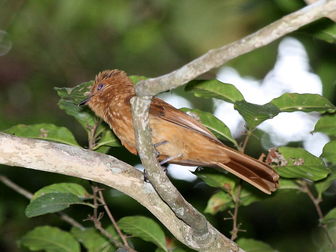Rufous Mourner
The Rufous Mourner is 20 cm. long and weighs 40 g. Its plumage is entirely rufous, brighter on the underparts, and with darker brown wings. The base of the bill is pink or horn-coloured. The call is a drawling way teeer and the song is wee hi hi weeur-weeur-weeur.

Original source: Dominic SheronyPermission(Reusing this file)This image, which was originally posted to Flickr.com, was uploaded to Commons using Flickr upload bot on 19:00, 21 April 2010 (UTC) by Howcheng (talk). On that date it was licensed under the license below. This file is licensed under the Creative Commons Attribution-Share Alike 2.0 Generic license.You are free:to share – to copy, distribute and transmit the work
Author: Dominic SheronyPermission(Reusing this file)This image, which was originally posted to Flickr.com, was uploaded to Commons using Flickr upload bot on 19:00, 21 April 2010 (UTC) by Howcheng (talk). On that date it was licensed under the license below. This file is licensed under the Creative Commons Attribution-Share Alike 2.0 Generic license.You are free:to share – to copy, distribute and transmit the work
The Rufous Mourner is classified as Least Concern. Does not qualify for a more at risk category. Widespread and abundant taxa are included in this category.
The Rufous Mourner, Rhytipterna holerythra, is a small passerine bird in the tyrant flycatcher family. It breeds from southwestern Mexico to northwestern Ecuador. It was formerly believed to be a cotinga, but well-supported anatomical evidence has shown it to be related to tyrant flycatchers of the genera Myiarchus, Sirystes and Casiornis. The Rufous Mourner is 20 cm. long and weighs 40 g. Its plumage is entirely rufous, brighter on the underparts, and with darker brown wings. More
The Rufous Mourner is 20 cm long and weighs 40 g. Its plumage is entirely rufous, brighter on the underparts, and with darker brown wings. The base of the bill is pink or horn-coloured. The Rufous Mourner is seen alone, in family groups or as part of a mixed-species feeding flock. It perches on a twig from which it sallies forth to catch large insects and caterpillars and many seeds and berries. All the food is taken in flight. More
saltator, rufous mourner, plain xenops, spotted woodcreeper, barred puffbird, chestnut-mandibled toucan, a bi-coloured antbird that I didn't realise I was filming, and a magnificent spotted antbird. Back at Canande Lodge we have a lizard, white-necked jacobin, blue-grey tanager, red-capped manakin, broad-billed motmot and purple-crowned fairy, before returning to the Botrosa Road for rufous-tailed jacamar, slaty spinetail, black-capped pygmy-tyrant, grey-headed kite. More
Family : Tyrannidae
Genus : Rhytipterna
Species : holerythra
Authority : (Sclater & Salvin, 1860)

